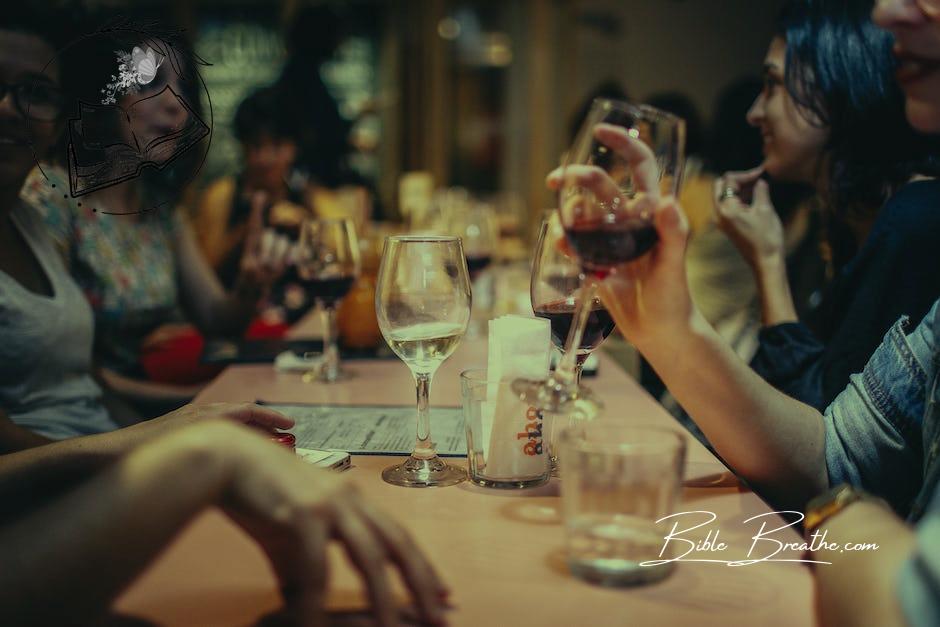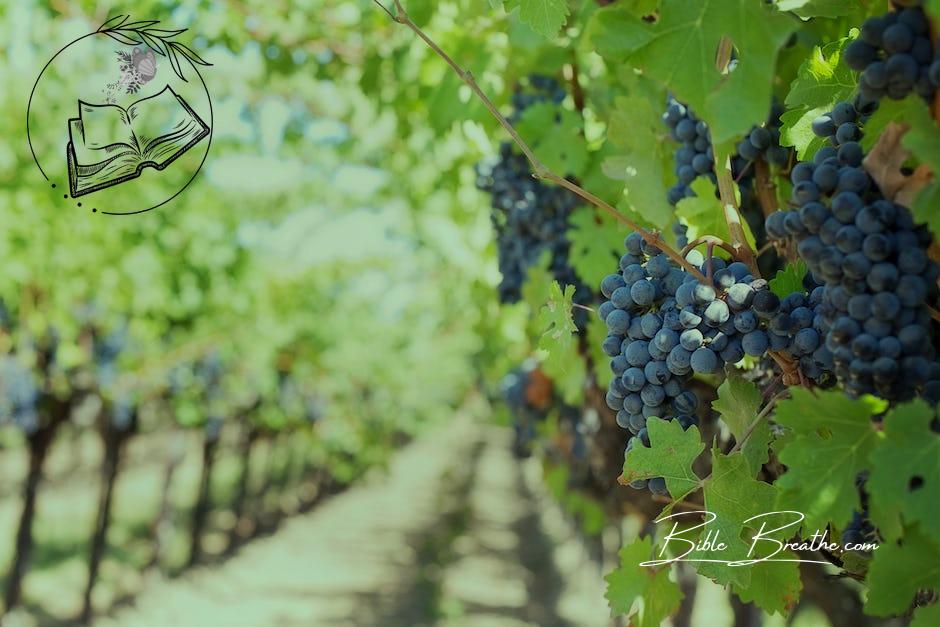How in the world did they whip up that grape goodness back in biblical days?
Can you imagine Jesus and his disciples toasting with a cup of that ancient vino?
Well, friend, that’s what we’re diving into today.
We’re going on a little journey through time to discover the secrets of winemaking in Bible times.
Grab your curiosity, and let’s embark!
Now, picture this: wine in those days wasn’t just a fancy beverage.
It was like a treasure chest of culture, history, and spirituality.
You see, grapes weren’t just grown; they were nurtured like a cherished garden.
The process of making wine was like crafting a masterpiece.
Back when Jesus walked among us, there was a whole world of wisdom in wine in Jesus’ era.
From the way they stomped those grapes, yeah, grape-stomping was a thing, to the fascinating practice of wine dilution in ancient Israel, it was a symphony of flavors.
As we explore the past, we’re not just peering into dusty history books; we’re stepping into vineyards, feeling the coolness of cellars, and tasting the essence of tradition.
It’s like an old, dusty bottle of knowledge we’re opening up, filled with stories of biblical winemaking, the mysteries of fermentation, and the beauty of wine aging.
So, here we are, friends, ready to unseal the ancient amphorae and pithos, unlocking the wisdom of those who came before us.
This isn’t just about wine; it’s about understanding the heart of our history and the art of turning grapes into something divine.
Let’s pour a glass and dive in.
🍷🌿
Key Takeaways
- Wine played an integral role in biblical history and culture, being used in various contexts such as religious rituals, celebrations, and everyday life. It held both symbolic and practical significance.
- Winemaking techniques in biblical times evolved gradually. Initially, grapes were crushed by foot, and the juice was fermented in clay jars or amphorae. Over time, advancements like winepresses and better storage methods improved the quality of wine.
- Wine had multifaceted uses beyond consumption. It was used for medicinal purposes, as a symbol of joy and abundance, and even in religious ceremonies. Its symbolism ranged from representing God’s blessings to the blood of Christ in Christian theology.
- Exploring biblical winemaking provides insight into the historical and cultural context of the Bible. It underscores the enduring significance of wine as a symbol and commodity throughout human history and its rich role in biblical narratives.
The Ancient Alchemy of Winemaking: A Biblical Perspective
Photo modified by BibleBreathe.com. Original photo by Markus Spiske on Pexels
In the grand tapestry of ancient times, the age-old craft of winemaking spins a tale as old as civilization itself.
Picture this: grapes basking in the sun, turning into a delightful nectar that danced on taste buds and uplifted spirits.
A Step Back in Time
Back in the day, winemaking was like a carefully choreographed dance.
Grapes, plump and sweet, were harvested from lush vineyards, treated like treasured guests as they entered the cellar, brimming with anticipation.
From Grape to Goblet: The Dawn of Winemaking
Ancient civilizations, from Georgia’s mountainous terrains to the timeless lands of Canaan and Egypt, led the way on this grape-filled journey.
They’d press the grapes in stone amphorae and pithos, vessels as ancient as time itself.
Imagine it like magic, as fermentation kicked off.
“”And no man putteth new wine into old bottles; else the new wine will burst the bottles, and be spilled, and the bottles shall perish. But new wine must be put into new bottles; and both are preserved.”” – Luke 5:37-38 (KJV)
Wine in Jesus’ Time
In the days of Jesus, wine wasn’t just a drink; it symbolized joy and celebration.
They’d employ age-old methods like grape trampling and precise aging to craft that perfect blend.
Fermentation was a crucial step, where the grape’s natural sugars transformed into alcohol.
They had their quality check, ensuring the wine retained its rich flavor and wasn’t diluted.
And oh, they had a special kind too—resinated wine, a unique specialty with a touch of resin for that extra flavor and preservation.
A Deeper Meaning
Just like wine matures and transforms with time, so does our grasp of the ancient world.
Unraveling the secrets of biblical winemaking is like taking a sip from the cup of history, tasting the essence of days long past.
So, here’s a toast to the artistry and science that our ancestors practiced, turning humble grapes into a timeless elixir.
The taste of history is as sweet and robust as the finest wine.
Cheers!
🍷
The Ageless Art of Crafting Wine in Biblical Days
Photo modified by BibleBreathe.com. Original photo by Markus Spiske on Pexels
Imagine wandering through the sun-kissed lands of ancient Israel, where vineyards stretched like vibrant tapestries.
In those bygone days, the making of wine was more than a skill—it was an art, a dance, a cherished craft passed down through generations.
Dancing with Grapes: Trampling and Juicing
Picture this lively scene: clusters of plump grapes, ripe with the promise of wine, carefully harvested and brought to the pressing floor.
It was a bit like a lively dance, where the grapes were placed in a large vat, ready to be transformed.
But it wasn’t just about squeezing; it was about rhythmically trampling the grapes underfoot.
This ancient practice allowed for a gentle extraction of the juice.
“”It’s like sipping the wine of astonishment.”” – Psalm 60:3 (KJV)
The juice, brimming with natural sugars, carried the essence of what would become wine.
Trampling wasn’t merely a practical technique; it was a cultural act, symbolizing unity and shared effort.
The Magic of Fermentation: From Juice to Wine
Once the juice was extracted, it was carefully collected in special vessels like amphorae and pithos—reminiscent of ancient wine barrels.
These vessels were crucial for the next part of the journey: fermentation.
As time passed, the natural sugars in the juice underwent a magical transformation, turning into alcohol.
“”You can’t pour new wine into old bottles. If you do, the new wine will burst the old bottles, and it’ll all be a mess. New wine needs new bottles; they go together like mac and cheese.”” – Luke 5:37-38 (KJV)
Fermentation was a delicate process, akin to nurturing a young bird in its nest.
Vintners watched over the vessels, ensuring the alchemy of transformation happened smoothly.
The Melody of Wine: Regional Flavors
In the diverse landscapes of ancient Israel, the symphony of winemaking played in different melodies.
Each region had its unique methods and preferences, painting varied flavors and textures.
From the arid Negev desert to the lush hills of Galilee, the land added its distinctive touch to the wine.
The ancient Israelites truly grasped the soul of winemaking.
They knew that in every sip of wine, you could taste the story of their land, their toil, and their beliefs.
Today, when we uncork a bottle and savor the liquid echoes of this ancient art, we’re continuing a tradition that has stood the test of time.
Cheers to the timeless craft of winemaking!
🍇🍷
Safeguarding the Sweet Essence: Wine Preservation in Bible Days
Photo modified by BibleBreathe.com. Original photo by Helena Lopes on Pexels
In the biblical epochs, making sure the wine stayed fresh and delicious was an art of its own.
The storage techniques were as varied as the folks who crafted the drink.
Amphorae: Time-Honored Wine Keepers
In the rich history of wine, the amphora takes center stage.
These elegant clay vessels, with their unique narrow necks and double handles, cradled the precious wine.
The design was deliberate, blending practicality with preservation.
“Neither do men put new wine into old bottles: else the bottles break, and the wine runneth out, and the bottles perish: but they put new wine into new bottles, and both are preserved.”” – Matthew 9:17 (KJV)
The narrow necks minimized air exposure, a foe to wine’s freshness.
Like a loving guardian, the amphora shielded the wine from spoiling, letting it age gracefully.
Pithos: Clay Guardians of Flavor
Pithos, much like today’s wine barrel, played a significant role in ancient wine storage.
These sizable clay vessels with broad bodies allowed for long-term aging.
Their porous walls interacted with the wine, adding a distinct character to its taste.
Wine stored in pithos was like a melody, getting richer and more resonant with time.
The taste spun a story of patience and expertise.
Wineskins: Wine on the Move
Wineskins were the wanderer’s companion for ancient wine.
Made from animal hides, they were sturdy and flexible, ideal for travel.
As the world changed and trade expanded, the need for wine that could endure journeys grew.
The wineskins cradled the wine, preserving its essence as traders ventured across deserts and mountains.
Like a wandering soul cherishing its roots, wineskins carried the spirit of the land they hailed from.
The Barrel Revolution: Shaping Wine’s Tune
As time passed, the world witnessed a revolution—the advent of wooden barrels for wine storage.
Unlike clay, wood imparted a different essence to the wine, infusing it with unique flavors and aromas.
The taste evolved, presenting a new symphony to wine aficionados.
The barrel was the conductor, orchestrating the transformation of wine from mere liquid to a masterpiece.
Every sip became a note, and the aging process was the melodious composition.
The art of storing wine in biblical times was a ballet of tradition and necessity.
Whether cradled in an amphora, maturing in a pithos, or traveling in a wineskin, wine was the ageless muse singing the saga of civilizations.
As we uncork a bottle today, we, too, become a part of this timeless tale.
Here’s to safeguarding the essence and the art of wine.
🏺🍷
Sipping Time: The Unique Taste of Biblical Wine
Photo modified by BibleBreathe.com. Original photo by Helena Lopes on Pexels
Back in the days when Jesus strolled the earth, the flavor of wine carried a charm all its own—a melody composed by the hands of vintners and the whispers of time.
The Aging Dance: Perfecting Wine over Time
Wine, much like an intricate tapestry, gained depth and richness with age.
Aging it in clay amphorae or porous pithos was an art of patience.
Time infused the wine, turning it into a symphony of flavors and aromas.
“”And no one who has tasted old wine prefers new wine, for they say, ‘The old is better.'”” – Luke 5:39 (KJV)
With each passing day, the wine shared ancient vineyard secrets and tales from cellars.
Every sip was a journey through time, an echo of days long past.
Resin’s Tune: A Unique Flavor Note
Resin, drawn from pine trees, played a notable part in biblical winemaking.
It lined the amphorae, infusing the wine with a distinct resinous flavor.
It wasn’t just for preservation; it was an intentional addition to the symphony of tastes.
The resin’s presence added a vibrant note, a touch of earthiness to the wine.
Just as life’s experiences shape our character, resin shaped the character of the wine.
Ancient Flavors: Common Additions to the Palette
In the ancient wineries, vintners were like alchemists, experimenting with flavors and additives.
Honey, herbs, and even sea-water were added to craft diverse taste profiles.
It was like an artist selecting colors for a masterpiece.
“”Your lips, my bride, drip honey; honey and milk are under your tongue…”” – Song of Solomon 4:11 (KJV)
Each region boasted its own unique blend, a reflection of the land and its people.
Just as we celebrate diversity in today’s culinary world, the ancients celebrated the diversity of flavors in their wines.
In those times, wine wasn’t just a beverage; it was a story in a glass.
It narrated the toil of hands, the richness of the land, and the wisdom of ages.
Today, as we uncork a bottle and savor those ancient notes, we take a sip through time, honoring an age-old tradition that still holds its magic.
Here’s to the taste of history, ever aged and ever cherished.
🍇🍷
The Balanced Brew: Merging Tradition and Wisdom in Biblical Wine
Photo modified by BibleBreathe.com. Original photo by Jill Wellington on Pexels
In the vibrant tapestry of the first century, wine held a prominent spot—treasured not only for its flavor but also for its cultural and symbolic importance.
One intriguing facet was the art of blending wine with water, a practice that added depth and richness to the experience.
The Symphony of Water and Wine: The Art of Dilution
Picture painting a masterpiece; each brushstroke contributes to the final beauty.
Likewise, diluting wine was akin to an artist’s delicate strokes.
Water was added not to diminish the experience, but to enrich it.
“But thou hast kept the good wine until now.”” – John 2:10 (KJV)
The reasons were as diverse as the colors on a palette.
Watered wine allowed hosts to extend the quantity of wine, ensuring a hospitable offering to all guests.
It was an act of wisdom and generosity, echoing the significance of sharing.
Relishing the Blend: Cultural and Health Insights
The blend of water and wine went beyond practicality; it carried cultural and health implications.
Water, crucial for hydration in that land, was a necessity.
It also discouraged excess, promoting a culture of temperance and responsible enjoyment.
In a way, it was a reminder of life’s delicate balance, where the merger of opposing elements often crafted harmony.
“”Give strong drink unto him that is ready to perish, and wine unto those that be of heavy hearts.”” – Proverbs 31:6 (KJV)
As we journey through the pages of history, we gain a deeper appreciation for the wisdom and customs of ancient times.
Watered wine was a practice steeped in meaning, a testament to the art of balance, generosity, and the harmony that defined the ancient world.
It was a fusion of tradition and wisdom, reflecting the essence of a bygone era.
Here’s to raising our glasses in honor of an ancient art, forever evolving yet deeply rooted in the sands of time.
🍷💧
The First Century Vintage: Beyond the Goblet
Photo modified by BibleBreathe.com. Original photo by Timur Saglambilek on Pexels
In the first century, wine wasn’t just a treat for the taste buds; it was a versatile elixir with many hats, each showcasing the ingenuity of the age.
The Sanitizing Sip: Wine as a Disinfectant
In a world without antiseptics and modern sanitizers, wine was a trusted disinfectant.
Its alcohol content played the role of a fierce warrior against unseen enemies.
Like a shield, wine stood guard, ensuring cleanliness and safety.
In a time when health was invaluable, wine was more than a soul-soothing delight; it was a testament to human ingenuity, making the most of available resources for the greater good.
A Sacred Toast: Wine in Religious Rites
Wine held a sacred position in religious ceremonies.
It went beyond being a drink; it was a symbol of life, sacrifice, and communion.
Sharing and pouring wine was akin to presenting a piece of oneself to the divine.
“”He took the cup, gave thanks, and gave it to them, saying, Drink all of it; This is my blood of the new testament, shed for many for the forgiveness of sins.”” – Matthew 26:27-28 (KJV)
In these sacred moments, wine wasn’t just consumed; it embodied faith and reminded everyone of a higher purpose.
The many faces of wine in the first century demonstrated the adaptability and resourcefulness of the people of that era.
Whether safeguarding health or symbolizing the divine, wine proved to be more than a beverage—it was evidence of how life, culture, and spirituality were intricately woven together.
As we appreciate the role of wine in days gone by, let’s also relish its significance in our present, recognizing its legacy as a timeless elixir.
🍇🔥🍷
Frequently Asked Questions (FAQs) About How Did They Make Wine In Bible Times
How different was the taste of biblical wine from modern wine?
Biblical wine was different from modern wine in that it was typically less alcoholic and often mixed with water.
It was also fermented differently and varied in taste.
The Bible’s wine was more akin to a diluted, grape-based beverage compared to today’s stronger, refined wines.
Why was wine diluted with water in ancient times?
Diluting wine with water in ancient times was a common practice for various reasons, including reducing its alcohol content, ensuring clean drinking water, and adhering to social and cultural norms.
It allowed people to consume wine more safely and also made it last longer.
What were the common storage containers used for wine?
In ancient times, wines were often stored in clay amphorae or jars, leather bags, or wooden casks.
Amphorae, made of clay, were prevalent in Mediterranean regions.
Leather bags were used for short-term storage, while wooden casks became popular later for larger-scale wine storage, transportation, and aging.







